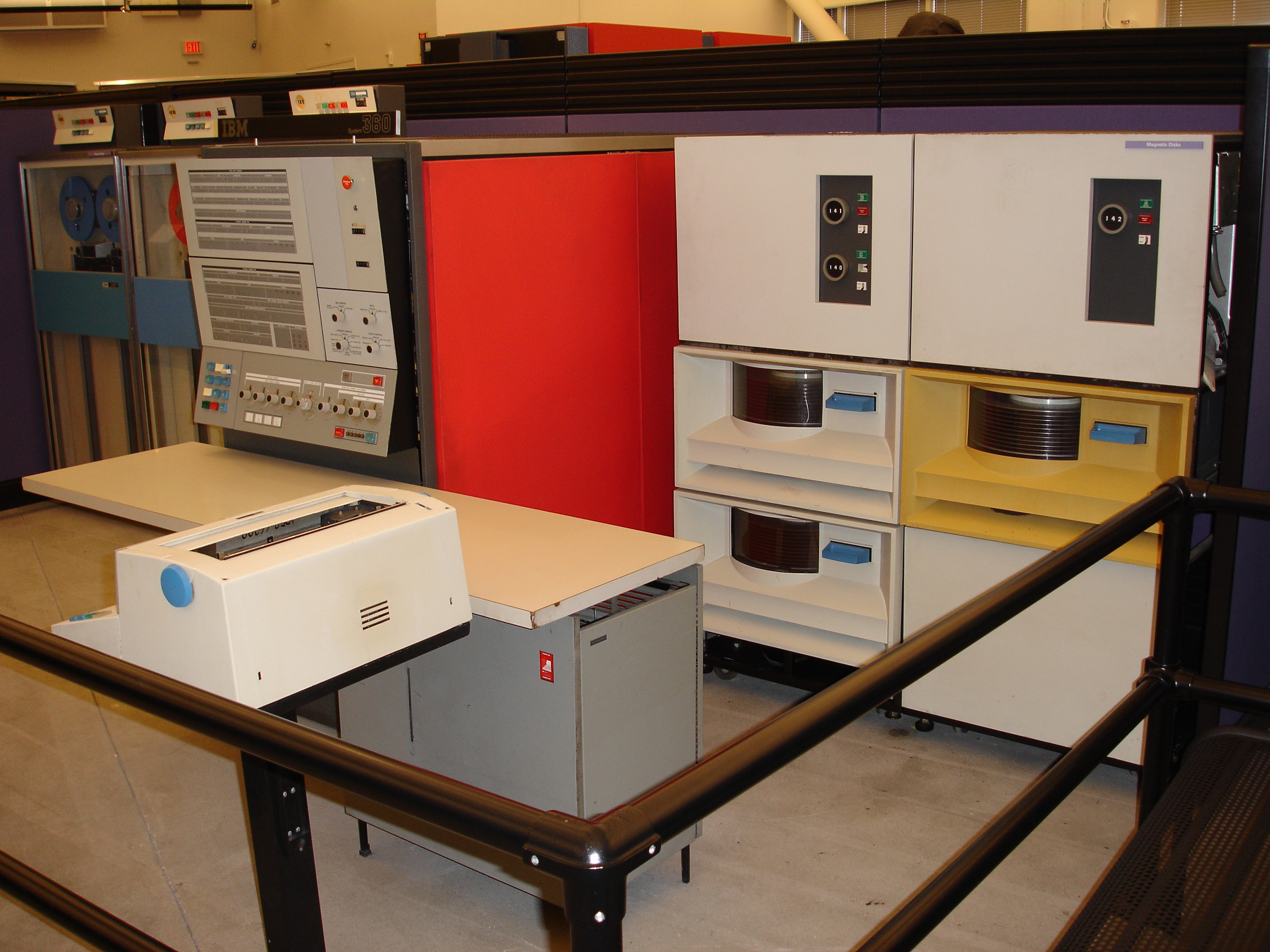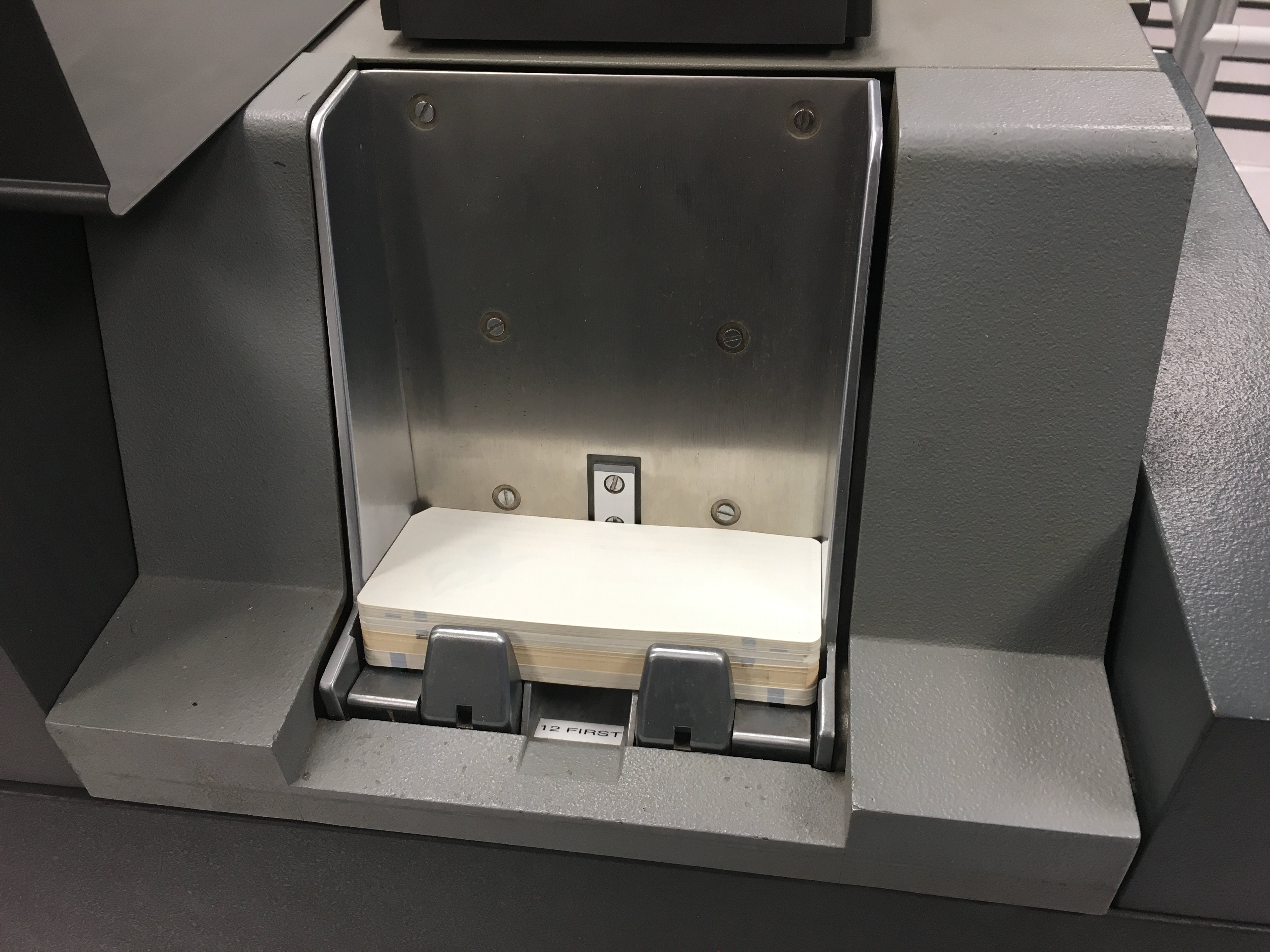|
Card Punch
A computer punched card reader or just computer card reader is a computer input device used to read Computer program, computer programs in either source or executable form and Data (computing), data from punched cards. A computer card punch is a computer output device that punches holes in cards. Sometimes computer punch card readers were combined with computer card punches and, later, other devices to form multifunction machines. History Many early computers, such as the ENIAC, and the IBM Naval Ordnance Research Calculator, IBM NORC, provided for punched card input/output. Card readers and punches, either connected to computers or in off-line card to/from magnetic tape configurations, were ubiquitous through the mid-1970s. Punched cards had been in use since the 1890s; their technology was mature and reliable. Card readers and punches developed for Unit record equipment, punched card machines were readily adaptable for computer use. Businesses were familiar with storing data ... [...More Info...] [...Related Items...] OR: [Wikipedia] [Google] [Baidu] |
Digital Equipment Corporation
Digital Equipment Corporation (DEC ), using the trademark Digital, was a major American company in the computer industry from the 1960s to the 1990s. The company was co-founded by Ken Olsen and Harlan Anderson in 1957. Olsen was president until he was forced to resign in 1992, after the company had gone into precipitous decline. The company produced many different product lines over its history. It is best known for the work in the minicomputer market starting in the early 1960s. The company produced a series of machines known as the Programmed Data Processor, PDP line, with the PDP-8 and PDP-11 being among the most successful minis in history. Their success was only surpassed by another DEC product, the late-1970s VAX "supermini" systems that were designed to replace the PDP-11. Although a number of competitors had successfully competed with Digital through the 1970s, the VAX cemented the company's place as a leading vendor in the computer space. As microcomputers improved in t ... [...More Info...] [...Related Items...] OR: [Wikipedia] [Google] [Baidu] |
IBM System/360 Model 20
The IBM System/360 Model 20 is the smallest member of the IBM System/360 family announced in November 1964. The Model 20 supports only a subset of the System/360 instruction set, with binary numbers limited to 16 bits and no floating point arithmetic. In later years it would have been classified as a 16-bit minicomputer rather than a mainframe, but the term "minicomputer" was not current, and in any case IBM wanted to emphasize the compatibility of the Model 20 rather than its differences from the rest of the System/360 line. It does, however, have the full System/360 decimal instruction set, that allows for addition, subtraction, product, and dividend of up to 31 decimal digits. Developed by IBM in Böblingen, Germany, the system was intended for data processing and as a replacement for tabulating equipment. An incompatible small computer, the IBM 1130 introduced the following year, was designed for scientific and engineering computing. The design of the Model 20 was the resul ... [...More Info...] [...Related Items...] OR: [Wikipedia] [Google] [Baidu] |
System 360
The IBM System/360 (S/360) is a family of mainframe computer systems announced by IBM on April 7, 1964, and delivered between 1965 and 1978. System/360 was the first family of computers designed to cover both commercial and scientific applications and a complete range of applications from small to large. The design distinguished between architecture and implementation, allowing IBM to release a suite of compatible designs at different prices. All but the only partially compatible Model 44 and the most expensive systems use microcode to implement the instruction set, featuring 8-bit byte addressing and fixed-point binary, fixed-point decimal and hexadecimal floating-point calculations. The System/360 family introduced IBM's Solid Logic Technology (SLT), which packed more transistors onto a circuit card, allowing more powerful but smaller computers. System/360's chief architect was Gene Amdahl, and the project was managed by Fred Brooks, responsible to Chairman Thomas J. Watson ... [...More Info...] [...Related Items...] OR: [Wikipedia] [Google] [Baidu] |
IBM 2540
The IBM 2540 is a punched-card computer peripheral manufactured by IBM Corporation for use of System/360 and later computer systems. The 2540 was designed by IBM's Data Processing Division in Rochester, Minnesota, and was introduced in 1965. The 2540 can read punched-cards at 1000 cards per minute (CPM) and punch at 300 CPM. The 2540 is based on the design of the older, slightly slower, 1402. Description The 2540 attaches to a System/360 multiplexer or selector channel through an IBM 2821 Control Unit. A standard 2540 processes standard IBM 80 column punched cards. The card reader (2540R) and card punch (2540P) devices are separately addressable and function independently. The 2540 normally reads and punches EBCDIC data, called data-mode 1. Card reader On the right side of the device is the reader, consisting of an input hopper holding approximately 3100 cards, and three output stackers (right to left – R1, R2, and RP3) each holding approximately 1350 cards. Cards can ... [...More Info...] [...Related Items...] OR: [Wikipedia] [Google] [Baidu] |
IBM 1440
The IBM 1440 computer was announced by IBM October 11, 1962. This member of the IBM 1400 series was described many years later as "essentially a lower-cost version of the 1401", and programs for the 1440 could easily be adapted to run on the IBM 1401. Despite what IBM described as "special features ... to meet immediate data processing requirements and ... to absorb increased demands," the 1440 did not quite attain the same commercial success as the 1401, and it was withdrawn on February 8, 1971. Author Emerson Pugh wrote that the 1440 "did poorly in the marketplace because it was initially offered without the ability to attach magnetic tape units as well." (referring to offering both tape and disk). System configuration The IBM 1441 processing unit (CPU) contained arithmetic and logic circuits and up to 16,000 alphanumeric Magnetic-core memory, storage positions. The console was either a Model 1 or, when an electric typewriter was added, a Model 2, of the IBM 1447 operator's ... [...More Info...] [...Related Items...] OR: [Wikipedia] [Google] [Baidu] |
IBM 1442
IBM 1442 is a combination IBM card reader and card punch. It reads and punches 80-column IBM-format punched cards and is used on the IBM 1440, the IBM 1130, the IBM 1800 and System/360 and is an option on the IBM System/3. Overview The 1442 can read up to 400 cards per minute. Cards are read and punched one column at a time and binary cards are permitted. Cards are read using photocells, illuminated by fiber optics, unlike the IBM 1402, which uses wire brushes to read cards. It is even possible to create (but not read, except in Binary Mode) " IBM Doilies," cards with every possible hole punched. Few other pieces of IBM equipment could do this without sustaining damage. There are two output stackers, located in the photo on the left lower side. One could program to select the output stacker for each card read, so it is possible to read cards and separate them into two groups. Cards are placed in the top hopper ("face down, nine-edge leading") and a plate is added on the top ... [...More Info...] [...Related Items...] OR: [Wikipedia] [Google] [Baidu] |
IBM 1401
The IBM 1401 is a variable word length computer, variable-wordlength decimal computer that was announced by IBM on October 5, 1959. The first member of the highly successful IBM 1400 series, it was aimed at replacing unit record equipment for processing data stored on punched cards and at providing peripheral services for larger computers. The 1401 is considered by IBM to be the Ford Model T, Ford Model-T of the computer industry due to its mass appeal. Over 12,000 units were produced and many were leased or resold after they were replaced with newer technology. The 1401 was withdrawn on February 8, 1971. History The 1401 project evolved from an IBM project named "World Wide Accounting Machine" (WWAM), which in turn was a reaction to the success of the Bull Gamma 3. The 1401 was used as an independent system in conjunction with IBM punched card equipment. It was also operated as auxiliary equipment to IBM 700/7000 series, IBM 700 or 7000 series systems. Monthly rental for 140 ... [...More Info...] [...Related Items...] OR: [Wikipedia] [Google] [Baidu] |
IBM 1402
The IBM 1402 was a high-speed Punched card reader, card reader/punch introduced on October 5, 1959 as a peripheral input/output device for the IBM 1401 computer. It was later used with other computers of the IBM 1400 series and IBM 700/7000 series, IBM 7000 series product lines. It was adapted as the IBM 1622 Card Read-Punch for the IBM 1620 and provided the basic design for the models IBM 2501, 2501, IBM 2520, 2520 and IBM 2540, 2540 equipment used with the IBM System/360 product line. Specifications Card reader * Card read speed up to 800 punched cards per minute (models 1, 2 and 3) or 450 cards per minute (models 4, 5 and 6). * Card input file for 3,000 cards (models 1, 2, 3, 4 and 6) or feed hopper for 1,200 cards (model 5). * Three stackers (NR, 1, 2/8) with approximately 1,000-card capacity hold cards after they are read. Card punch * Card punch speed up to 250 cards per minute (all models). * Feed hopper for 1,200 cards (all models). * Three stackers (NP, 4, 2/ ... [...More Info...] [...Related Items...] OR: [Wikipedia] [Google] [Baidu] |
IBM 2501
The IBM 2501 is a punched-card reader from IBM with models for the System/360 and System/370 mainframe systems and for the IBM System/360 Model 20, the IBM 1130 and IBM System/3 minicomputers. 2501 models can read 80-column cards at either 600 or 1000 cards per minute (CPM). The 2501 is no longer sold, but is simulated in software on current IBM systems. Models The 2501 comes in four models depending on speed and attachment features. Models for mainframe use come with an ''integrated control unit'' that performs the functions of a control unit required by other devices. The A1 and A2 are for the IBM 1130. Usage The 2501 uses a photoelectric sensor to read the data punched in the card. Cards are read ''serially'' (column by column) and the reader uses a simplified "straight through" card path. "Each column is read twice and the two readings are compared to check reading accuracy." In a mainframe environment the 2501 was frequently used for mainframe input in an "open shop" ... [...More Info...] [...Related Items...] OR: [Wikipedia] [Google] [Baidu] |
IBM 711
The IBM 711 was a punched card reader used as a peripheral device for IBM mainframe vacuum tube computers and early transistorized computers. Announced on May 21, 1952, it was first shipped with the IBM 701. Later IBM computers that used it were the IBM 704, the IBM 709, and the transistorized IBM 7090 and 7094. Overview The 711's read mechanism was based on the IBM 402's and could read 150 cards per minute (250 cards per minute on the IBM 7090). It included a control panel that could be wired to transfer any 72 columns out of the 80 on a card into the computer's memory, though in practice the panel was almost always wired to read the first 72 columns. Cards were read in binary format. Data from each row was read into two 36-bit words, starting with row 9, for a total of 24 words per card. Computer object code could then be executed directly. Conversion to characters or numbers was done in software. The 72 column restriction influenced early computer languages, such as Fortran a ... [...More Info...] [...Related Items...] OR: [Wikipedia] [Google] [Baidu] |





